Store Samples |
2025-07-08 |
Once you have configured at least one storage system with some terminal storage units, you can assign samples to the virtual location corresponding to their physical location. Any protocol about where to place samples of different types can be accommodated in this system.To add samples to storage, the user must have been granted the Storage Editor role or be an administrator. This topic assumes the user has this role.
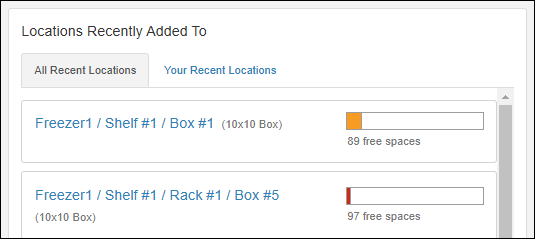 If you know the name or label of the storage unit you want to use, you can search for it directly. Click it in the search results, then skip to adding your samples to it.Otherwise, start from the Storage List on the Storage dashboard. You'll see a summary of storage and how many spaces are available for samples in each to guide you.
If you know the name or label of the storage unit you want to use, you can search for it directly. Click it in the search results, then skip to adding your samples to it.Otherwise, start from the Storage List on the Storage dashboard. You'll see a summary of storage and how many spaces are available for samples in each to guide you.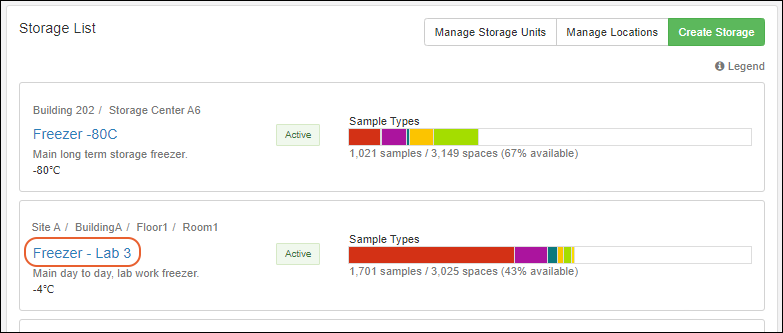 Click the name of the storage to open the details page.
Click the name of the storage to open the details page.
 Continue to use the to expand until you find enough capacity in terminal storage units where your samples can be stored. Note that if you cannot find sufficient space, you can also add new storage when you are adding samples to storage from a grid.Click any location in the left panel to show it's summary information on the right. You can only store samples in "terminal" storage locations: bags, boxes, canes, plates, and tube racks.
Continue to use the to expand until you find enough capacity in terminal storage units where your samples can be stored. Note that if you cannot find sufficient space, you can also add new storage when you are adding samples to storage from a grid.Click any location in the left panel to show it's summary information on the right. You can only store samples in "terminal" storage locations: bags, boxes, canes, plates, and tube racks.
 You are now on the Storage View tab for this storage, open to the location you selected.
You are now on the Storage View tab for this storage, open to the location you selected.
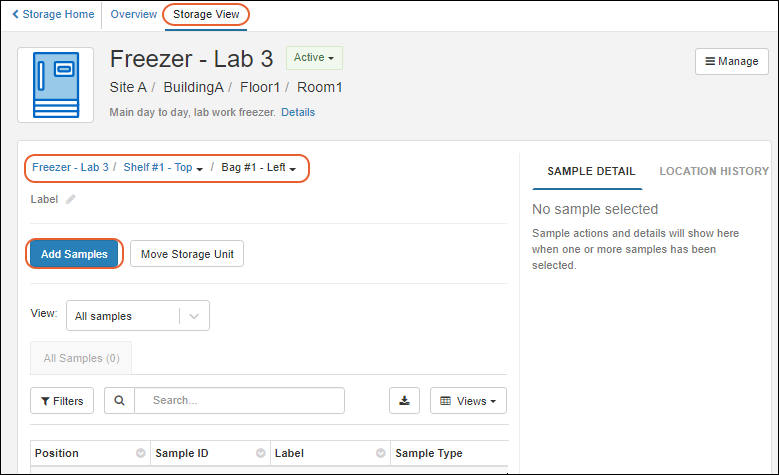
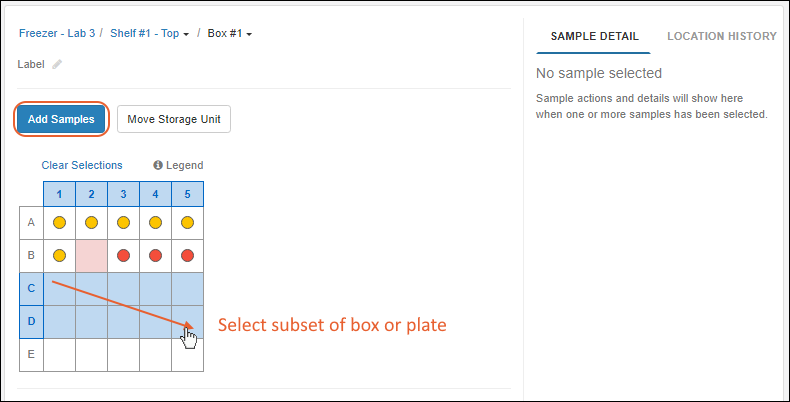 A popup modal will help you add the samples.For a box, plate, or tube rack, the left side of the panel previews the storage layout, with any selection you made. The right side of the popup offers both a grid entry option and a way to search for samples. You can also specify the fill order, direction, and (if no cell selection was made) the starting location for the samples you are adding.
A popup modal will help you add the samples.For a box, plate, or tube rack, the left side of the panel previews the storage layout, with any selection you made. The right side of the popup offers both a grid entry option and a way to search for samples. You can also specify the fill order, direction, and (if no cell selection was made) the starting location for the samples you are adding. For a bag or cane, there is no layout preview, but a single panel for the grid entry option or searching for samples.
For a bag or cane, there is no layout preview, but a single panel for the grid entry option or searching for samples.
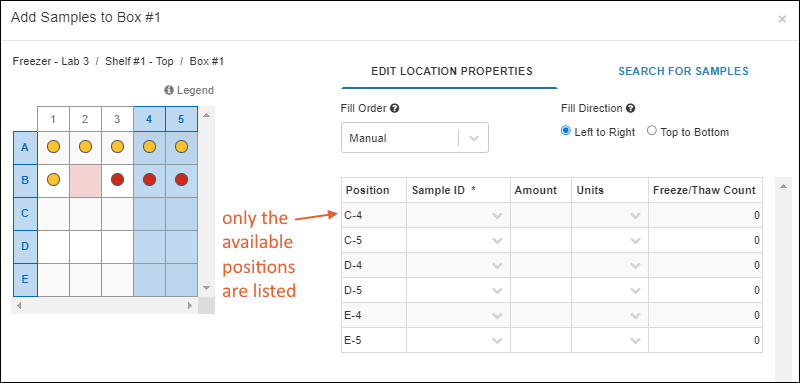
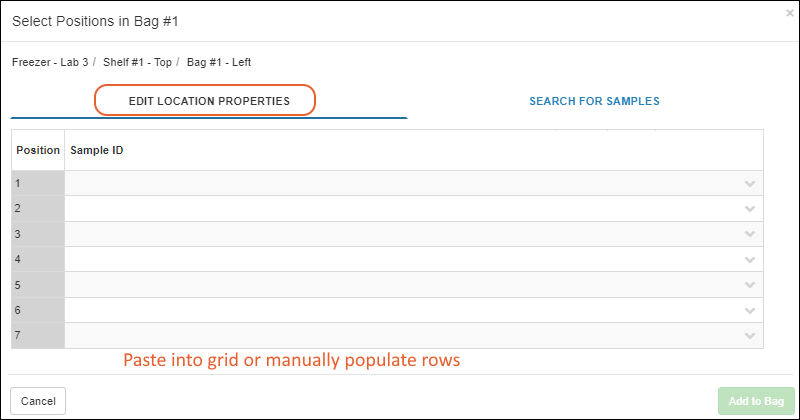 Values added to the Sample ID column must already exist in the system. If you start typing you will see a narrowing list of available samples. Note that this means if you received a new set of samples, you must first add them to a Sample Type before you can assign them to locations using this interface.
Values added to the Sample ID column must already exist in the system. If you start typing you will see a narrowing list of available samples. Note that this means if you received a new set of samples, you must first add them to a Sample Type before you can assign them to locations using this interface.
 Once a Sample Type has been selected, you can:
Once a Sample Type has been selected, you can:
 See below for how to Assign Positions once you've identified the samples you want to store.
See below for how to Assign Positions once you've identified the samples you want to store.
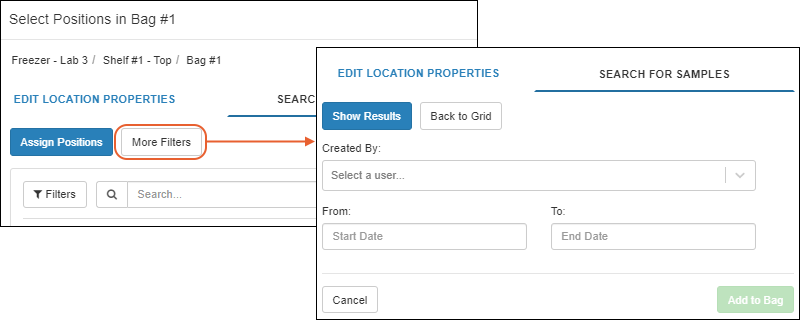
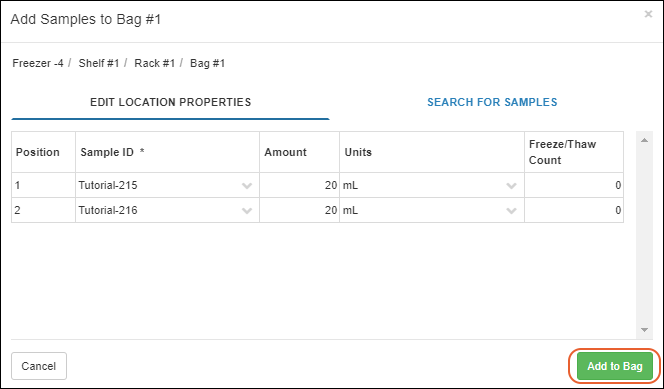 Box, plate, or tube rack:
Box, plate, or tube rack:


 You can further adjust these assignments by using copy/paste to move the rows in the assignment grid to other available positions in the layout.
You can further adjust these assignments by using copy/paste to move the rows in the assignment grid to other available positions in the layout.
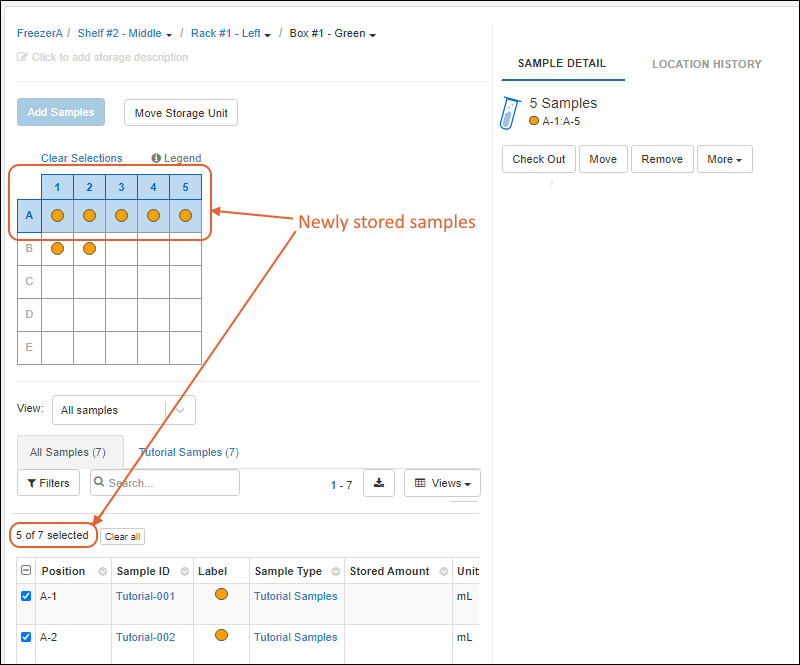
 If you are viewing details for an individual sample, you can also click Add to Storage from the Storage Location panel.Note that there are some situations where samples cannot be added to storage, such as a status that prevents the action or the user's permission in the folder where the sample is defined. You will see a banner warning describing any issues with the selected samples.
If you are viewing details for an individual sample, you can also click Add to Storage from the Storage Location panel.Note that there are some situations where samples cannot be added to storage, such as a status that prevents the action or the user's permission in the folder where the sample is defined. You will see a banner warning describing any issues with the selected samples.
 The Select link will switch to Clear, in case you change your mind at this point and want to select another location.
The Select link will switch to Clear, in case you change your mind at this point and want to select another location.

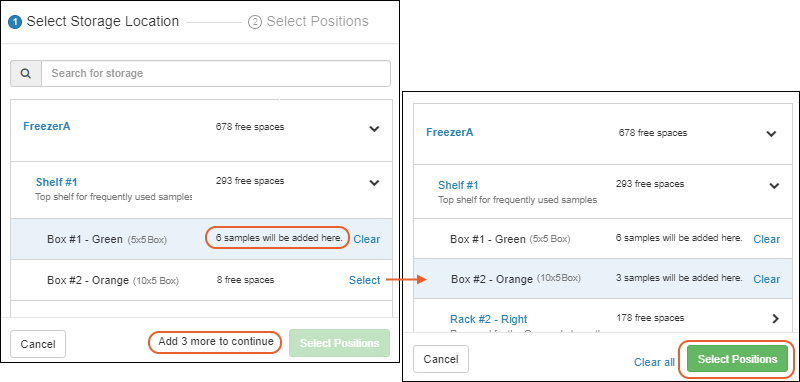 On the next panel, you will see the Storage Locations/Positions available and Sample IDs (plus any Identifying Fields that are set for reference). You can edit positions of samples here as needed.
On the next panel, you will see the Storage Locations/Positions available and Sample IDs (plus any Identifying Fields that are set for reference). You can edit positions of samples here as needed. When finished, click Add to Storage. The samples will be added directly to storage in the locations you selected. You will not see the same location assignment interface as when using a single destination storage unit and cannot further adjust positions at this point. After the action, you'll see a banner with the number added and a clickable link letting you View their storage locations here.
When finished, click Add to Storage. The samples will be added directly to storage in the locations you selected. You will not see the same location assignment interface as when using a single destination storage unit and cannot further adjust positions at this point. After the action, you'll see a banner with the number added and a clickable link letting you View their storage locations here.
Start from the Storage System
Start from a List or Grid of Samples
- Select Samples to Store
- Find Storage Location for Samples
- Automatic or Manual Location Assignment
- Store Samples in Multiple Locations Simultaneously
Start from the Storage System
Find Available Space
On the home page and the storage dashboard, you will see Locations Recently Added To. Click to open the most recent locations used either by anyone or specifically by you:- Here you'll see the top level of the storage hierarchy you defined. A note of the number of free spaces in each section is provided to assist you.
- Click the to expand the nested hierarchy.
- Each level will summarize space available and in the case of terminal storage, will show the specific storage unit name (i.e. bag size or box dimension).
- As you browse, the system will remember where you were in the hierarchy if you need to go back to a different branch.
- Click any level to see more details in the panel on the right.
- Click Go to Storage View to open it.
- You can also click the location name in the 'breadcrumb' trail along the top of the panel.
Select Space to Fill
There are two categories of terminal storage units to which you can add samples.- 1. Bags and Canes use a simple numbering scheme for positions.
- For bags and canes, you don't need to do anything except click Add Samples to activate the sample panel on the right.
- 2. Boxes, Plates, and Tube Racks have a 2D layout of row and column positions (aka cells, spaces, wells, etc.) within the unit. You have two choices here:
- Click cells or drag within the layout to select a range of positions, as shown below, then click Add Samples. The selected positions will be eligible for placing samples, provided they are not already occupied.
- OR, click Add Samples without making any selection. All available positions will be eligible for placing samples.
Position Already Occupied
If you select a range of cells and one (or more) are already occupied by samples, when you click Add Samples, you will see only the unoccupied positions in the grid.Identify Samples to Store
Edit Location Properties
On the Edit Location Properties tab, you can paste into the grid from a spreadsheet or by typing directly into the grid:Search for Samples
Click the Search for Samples tab to get more assistance with finding specific samples.First, select the desired Sample Type from the dropdown.- Find the samples you want by filtering, sorting and searching.
- Click More Filters to flip to a filters panel, described below.
More Filters
Click More Filters on the Search for Samples tab to select on or more of the filter options:- Created By: Find samples added by a specific user.
- From/To: Find samples created in a specified date range.
- Click Show Results to see the samples that match your filters.
- Use checkboxes to select the samples of interest, then click Assign Positions, or return for More Filters.
- Once some filters are applied, you'll be able to click Clear all filters to clear them.
- Use Back to Grid to return to the previous set of selected samples.
Assign Positions
Once you've filtered to find the samples you want, use checkboxes to select the ones you will be adding to this storage unit.- Note: If you select more samples than there are spaces available, you will see an error message telling you to reduce the number of selected samples before proceeding.
- Position:
- In the case of a bag, the numbered position is not meaningful.
- For a cane, it could be numbered from top to bottom (or bottom to top) as your convention dictates.
- For boxes, plates, and tube racks, the "Position" column corresponds to the layout on the left, which can use either Row/Column names or a numbering system. Learn about assigning specific positions below.
- Sample ID: the selected samples are listed, but you can add more rows directly. Sample IDs must already exist in the system.
Choose Fill Order, Starting Location, and Fill Direction
When you start from the storage and search for samples to add to a structured storage unit like a box, after clicking Assign Positions, you'll be able to select the order, starting point, and fill direction.- Fill Order:
- Manual (Default)
- Sample Creation Order
- Sample ID Ascending
- Sample ID Descending
- Starting Location:
- If you preselected cells, the first available spot in your selection is used and this dropdown is not offered.
- If not, then the first available spot in a storage unit is selected by default. You can specify another starting location if desired using the dropdown.
- Fill Direction:
- Left to Right
- Top to Bottom

Add to Storage
Click Add to [Storage Type] to complete the position assignments.After assignment is complete, you will see the Storage View for the location.- The newly added samples will be selected in the grid.
- In the case of a box, plate, or tube rack, the cells containing the newly placed samples will also be highlighted.
Start from a List or Grid of Samples
Instead of starting from the Storage, as described above, you can add Samples to storage starting from the sample grid, either while viewing the Sample Type as a whole, or starting from a curated picklist or Sample Finder search results.Select Samples to Store
Open the grid of Samples of interest and identify the Samples you want to store. Only Samples with a Storage Status of "Not in storage" can be added, so applying this as a filter can be helpful.Use checkboxes to select the Samples, then select Storage > Add to storage above the grid. On narrower browsers, this option will be on the More > menu.Find Storage Location(s) for Samples
In the Assign Samples to Storage popup, you will see storage systems with available storage space. The application will remember where samples of this type were last added and open to that location first. You can then navigate to other locations as needed.The number of spaces available at each level will help you see easily where there is room for your new samples. To quickly find particular storage you want, use the search box at the top of the panel to find storage units by name or label.Use the icons to expand the hierarchy of the storage of your choice, seeing available spaces at each level. You'll see unit names, as well as the type/size of terminal storage units to assist you.When you find the desired terminal storage unit, click Select. If necessary, you can also add new terminal storage units by clicking the for the level where you want them.For boxes and plates, you'll see a preview of the current contents of the storage on the right.Automatic or Manual Location Assignment
Once you have selected a storage location with enough space for all selected samples, click Select Positions. Starting from a list or grid of samples gives you somewhat different options than if you had started from the storage system to store them. By default, the samples will be placed in the first available layout positions, using left to right, then top to bottom sequencing. Select either:- Automatically Fill: Customize the fill order, starting point and fill direction.
- Manually Fill: Place them manually, with the option to change the fill direction to adjust how the rows are listed in the grid.
- Populate the grid with storage properties.
- Assign positions, make any position adjustments needed.
- Click Add to [Storage Type] to complete the position assignments.
Automatic Fill Options: Fill Order, Starting Location, Fill Direction
- Fill Order:
- Samples Grid Order (Default): This option reads "Manual" if you did not start from a sample grid.
- Sample Creation Order
- Sample ID Ascending
- Sample ID Descending
- Starting Location:
- By default, the first available spot in a storage unit is selected. You can specify another starting location if desired using the dropdown.